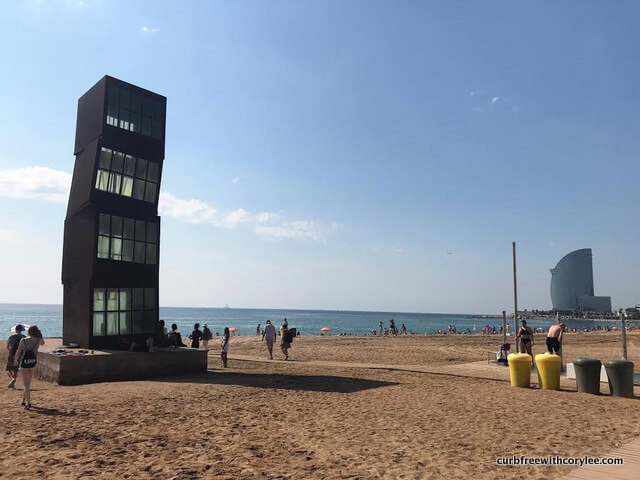
Wheelchair Accessible Barcelona Attractions & Barcelona Tourist Information
Sagrada Familia
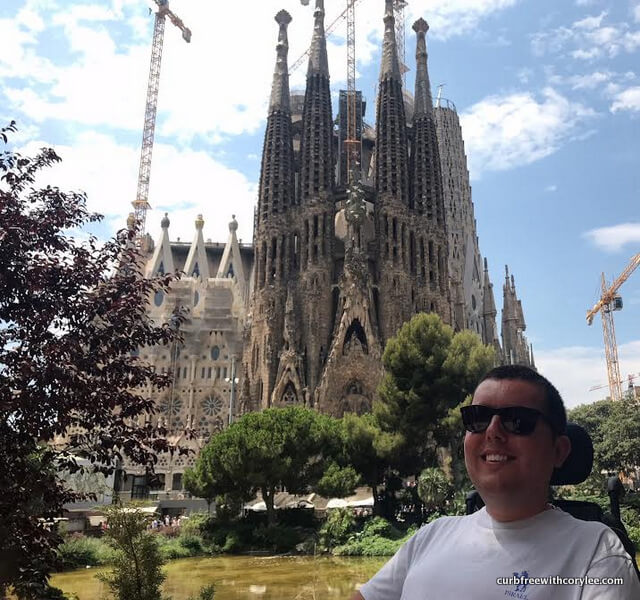
Why Visit: Designed by famous Catalan architect Antoni Gaudi, this UNESCO World Hertigate Site is a humongous unfinished cathedral that has been celebrated by many art historians as a unique interplay of Gothic and Art Nouveau architecture. I’m honestly not sure that I’ve ever seen anything quite as incredible!
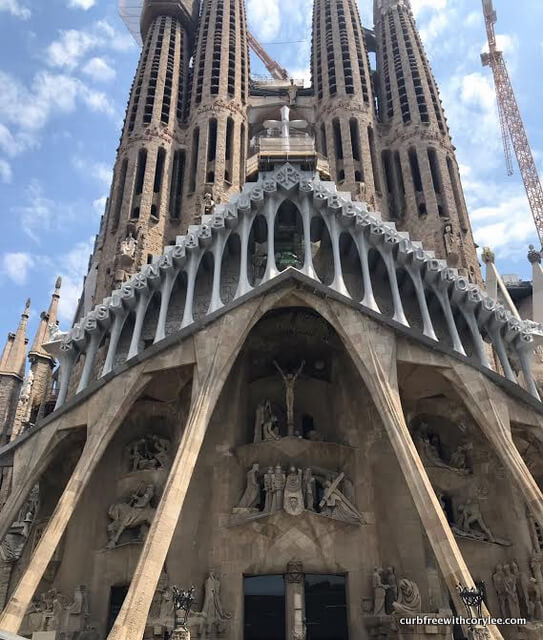
How to Visit: People with an accredited disability (along with one companion) and children under 10 years old can get in for free. If your party is larger, I think it’s easiest to buy tickets online here, to avoid any unnecessary waiting in person. You can buy a basic ticket that just gets you admission into the cathedral, or tickets for a 45-minute self-guided audio tour, a 50-minute guided tour, or the Gaudi House Museum to learn more about the well-known architect.
The Basilica is open from 9am to 6pm from November to February, 9am to 7pm in March, 9am to 8pm from April to September, and 9am to 7pm in October. It’s recommended to dress conservatively, and hats aren’t allowed inside unless they are worn for religious or medical reasons.
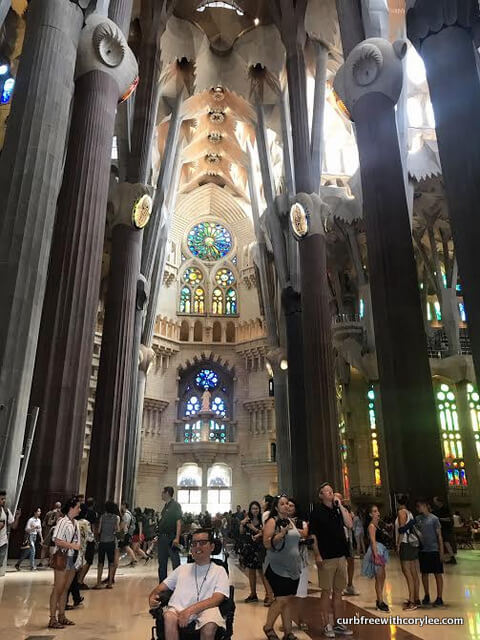
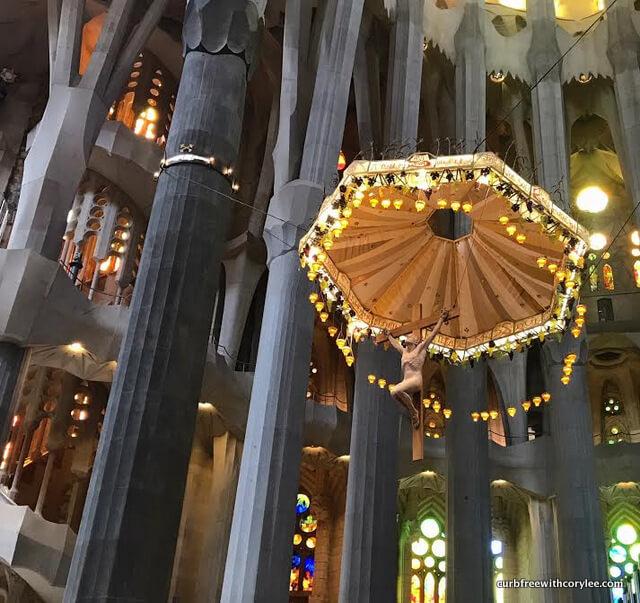
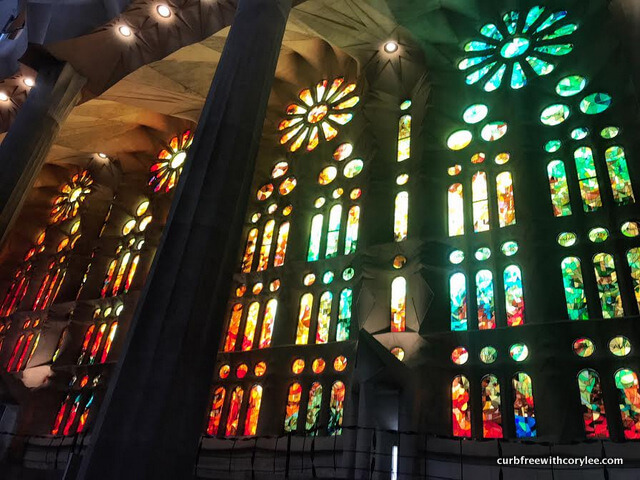
Accessibility: There are adapted tours of the cathedral for wheelchair users. If you need a wheelchair while there, the basilica can provide you with one if you contact them at [email protected]. Though wheelchair users can’t ascend the towers inside the cathedral, we can still see the best parts. It’s certainly possible to go inside this behemoth structure with a wheelchair, but the ramps can be quite steep for visitors with manual wheelchairs. However, I had no trouble in my powered chair and when I entered, the beauty literally brought me to tears!
.
La Pedrera
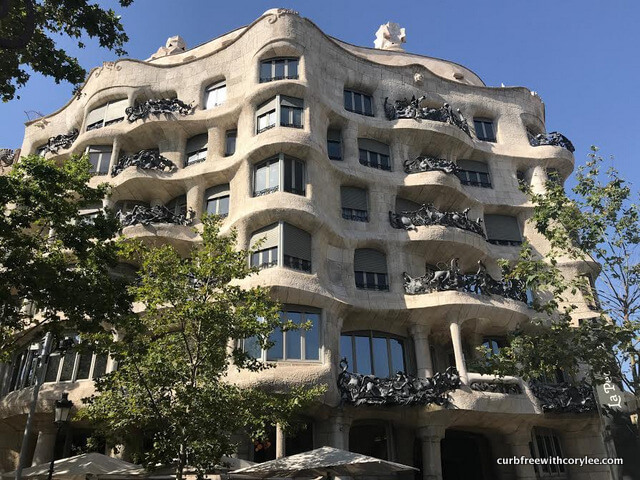
Why Visit: La Pedrera, also known as Casa Mila or “the stone quarry,” is another one of Gaudi’s architectural masterpieces that wheelchair accessible Barcelona is famous for – though this time, it’s a distinctive modernist structure. It was one of the first monuments in Spain to be declared a UNESCO World Heritage Site, and it’s billed as an essential stop for anyone looking to truly understand the creative genius of Antonio Gaudi.
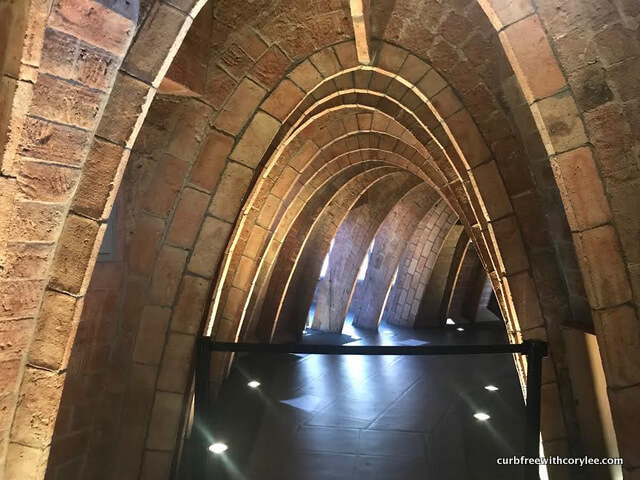
How to Visit: It’s estimated that visitors will spend at least an hour to an hour and a half here. La Pedrera is open from Monday to Sunday. If you visit during the daytime, hours are 9am to 8:30pm March 1st to November 4th and December 26th to January 3rd, or 9am to 6:30 pm from November 5th to February 28th. Alternatively, special nighttime tours are offered from 9pm to 11pm March 1st to November 4th and December 26th to January 3rd, or 7pm to 9pm from November 5th to February 28th.
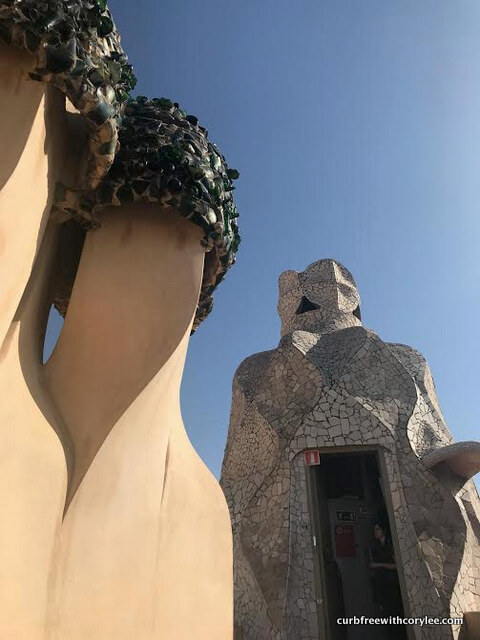
Accessibility: Wheelchair users can get in for free or a reduced rate, but you must provide official documentation of your disability. If you’re in a wheelchair, you can skip the lines and enter the building through the Passeig de Gracia entrance. Accessible visits come with a free audio guide and can be booked in advance by emailing [email protected], or staff will allow you to buy tickets without waiting whenever you arrive. If you book in advance, tour options are available to browse here (some come with coffee or cava!), and all are fully accessible with the exception of Gaudi’s Pedrera: The Origins, which is only partly accessible.
.
Mercat La Boqueria

Why Visit: Located in Las Ramblas, the center of wheelchair accessible Barcelona, the city’s premier market is an artsy, gastronomic attraction that is constantly buzzing with life. Plus, markets have been located in this very spot since the thirteenth century! I’ve traveled a lot and consider myself quite the market aficionado – they’re always one of my favorite places to visit because I feel like I can truly immerse myself in the daily, pulsating rhythm of a town or city. This means that I have fairly high standards as far as markets go, and Mercat La Boqueria did not disappoint! I loved wheeling around, smelling the sweet scents and sampling delicious foods — I particularly enjoyed a fresh juice while there.

How to Visit: The market is closed on Sundays and Mondays. It’s open Tuesday-Thursday from 8am to 3pm and Fridays and Saturdays from 8am to 5pm. Occasionally educational or cooking classes are offered, so I recommend checking the schedule in advance to plan your visit.

Accessibility: Aisles are narrow and La Boqueria is often busy with foot traffic, but isn’t that part of the marketplace charm? With some careful maneuvering, many of the stalls at the market are accessible, including some of the ones that offer up cooked treats! There are ramps in select places in the market, and vendors and visitors alike are usually polite and conscious of wheelchair users, allowing you to move somewhat freely through the crowds.
.
La Rambla
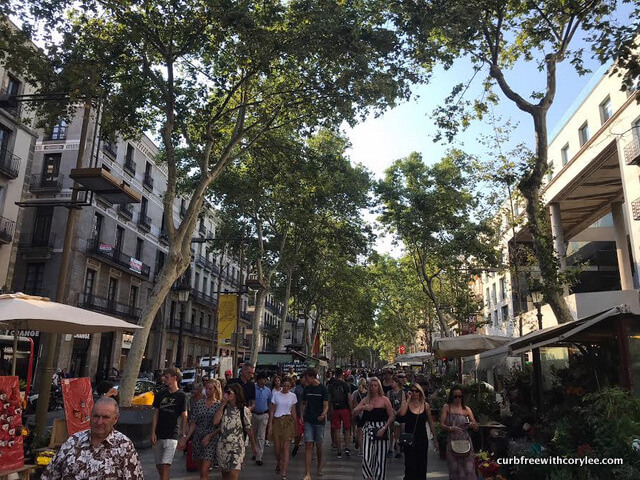
Why Visit: La Rambla is a central, tree-lined street in wheelchair accessible Barcelona that is a prime stop for tourists and shopping. It’s about 1.2 kilometers long, stretching from Plaça de Catalunya in the north to Port Vell in the south. One fun aspect of this street is that it’s famous for street performers, including human statues. While visiting, be sure to stop by La Boqueria market (discussed above) and the Christopher Columbus Monument. As you’re wheeling over the mosaic covering the street tiles near Liceu Theatre, take note that this was actually made by famous artist Joan Miro!
How to Visit: This one’s easy – simply show up, shop, and enjoy the ease of wheelchair accessible Barcelona. During the day, the whole promenade is safe to stroll around, but at night the southern end (south of the Liceu Theatre) becomes somewhat of a red light district, so I’d recommend visiting before dinnertime or sticking to the north end if you want to explore after dark. I think it’s best to stay elsewhere in the city because La Rambla can be noisy day and night, but there are plenty of accommodations along the boulevard if you’re all about the party life.
Accessibility: As a pedestrian street, La Rambla is a wide, roll-able expanse – much preferred to sidewalks. Occasionally the cobblestones can become a bit rickety (though only in certain places) and in spots some cars are allowed through, but the vast nature of the pedestrian-dominated road makes it fairly friendly for wheelchair users. It’s a basic safety precaution, but watch your valuables here as you may encounter the occasional pick-pocket.
.
National Art Museum of Catalonia

Why Visit: Home to over a thousand years of art, the museum is fantastic for everything from medieval to modernist. When I visited a couple of months ago, my favorite part was the new Gala Dali exhibit, although I really loved the rest of the museum, too! Certain points of the museum, including the terrace and the on-site restaurant, feature a stunning bird’s eye view of Barcelona.
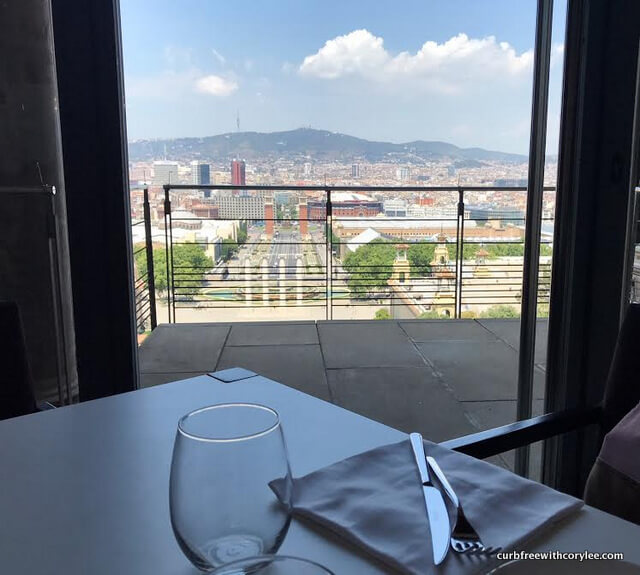
View from the on-site restaurant
How to Visit: There is an on-site restaurant at the museum which I ate at while there, and I’m happy to say that the food was delicious, though they’re not open on Mondays. From October to April, the museum is open Tuesday to Saturday, 10am to 6pm; Sundays and public holidays, 10am to 3pm. In the summer, the museum is open from May to September, Tuesday to Saturday, 10am to 8pm; Sundays and public holidays, 10am to 3pm. It is always closed on January 1st, May 1st and December 25th every year, so plan your visit accordingly.
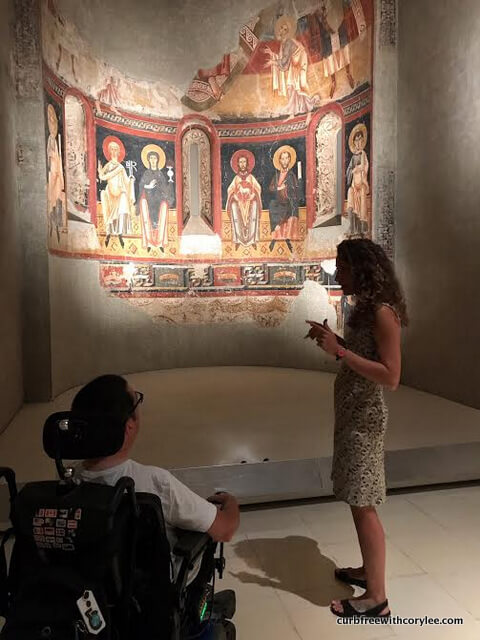
Accessibility: The majority of Museu Nacional d’Art de Catalunya is wheelchair accessible and was designed with wheelchair users in mind. There are lifts and stair-lifts when needed, and wheelchairs are available for guests in the cloakroom. Accessible restrooms are located in the foyer, Oval Room and the library, and you can find free accessible, municipal parking near the museum.
.
Montjuïc Cable Car
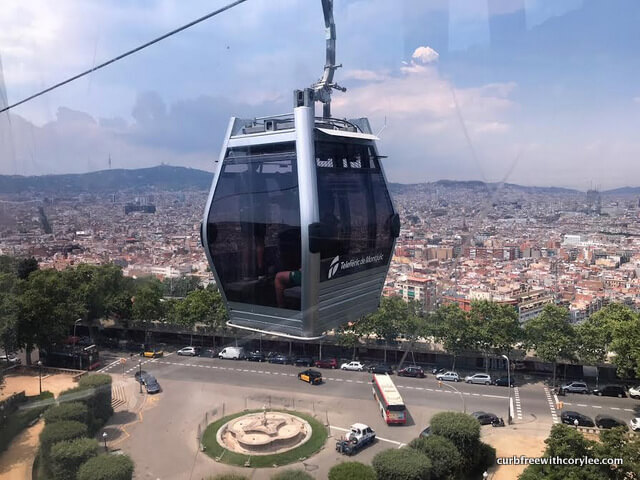
Why Visit: The fun gondola will take you on a ride up to the beautiful Montjuïc Castle, giving you epic, panoramic views of wheelchair accessible Barcelona all the while. There are three stations each with different views of the city from Montjuïc Mountain, going up a total of 750 meters.
How to Visit: I recommend purchasing your tickets online, as you can receive a 10% discount. You can access the cable car from one of three stops: Parc Montjuïc, Castell, and Mirador. The cable car opens at 10am year-round and closes at 6pm from November to February, 7pm from March to May and in October, and 9pm from June to September.
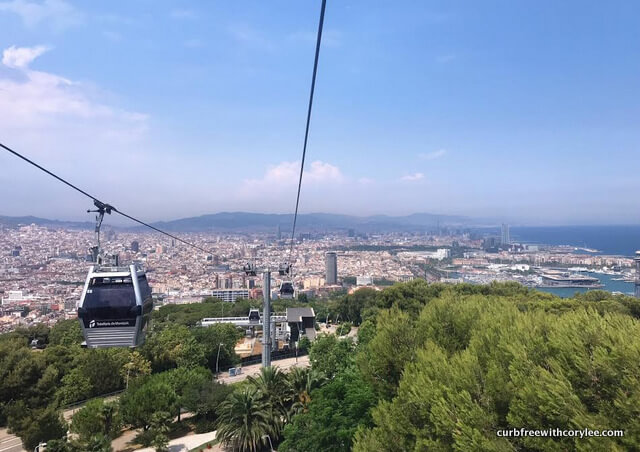
Accessibility: Cars are completely adapted for wheelchair users, and if you need any assistance at all, just ask one of the station’s friendly staff members! I loved the cable car, as the main other way up to the top would have been an exhausting and non-wheelchair friendly climb.
.
Pedralbes Park
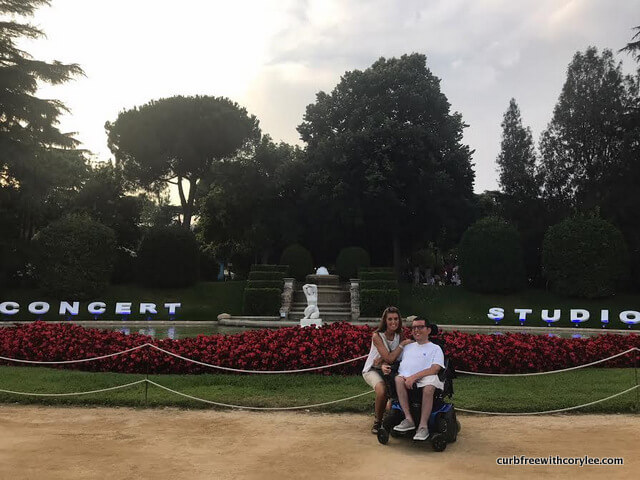
Why Visit: Located in Barcelona’s university area, this park features a palace and gardens – something you might not realize from simply looking at its name. Its stately nature alone merits a visit from anyone interested in classic European green spaces, but the fact that so many fun events are held here also makes it appealing. During my exploration of wheelchair accessible Barcelona, I went to Festival Jardins Pedralbes and saw Fleet Foxes perform. I loved the music of course, but the festival was amazing and the park’s beauty topped even that! Plus, it’s not one of the city’s two most famous parks, so you’re less likely to find tourists here and more likely to find local couples on romantic strolls, enjoying the scenery like you are.
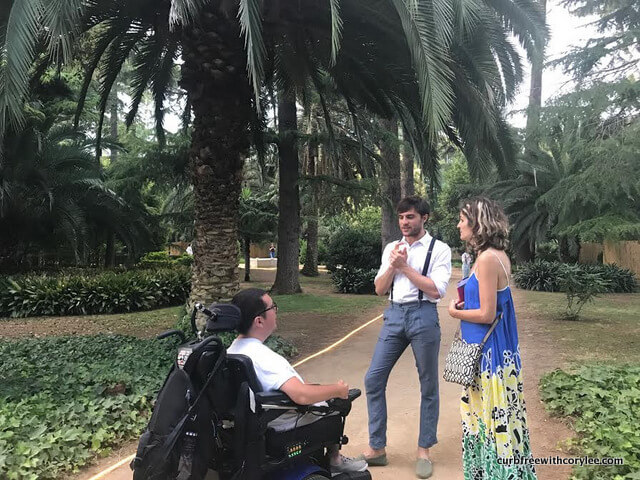
How to Visit: I recommend touring the park’s French-style palace and rolling among the flowers and ponds. Inside the palace you’ll find a Ceramics Museum and a Museum of Decorative Arts. Outside, you’ll find impeccably landscaped bushes and lots of greenery. The park is open from 10am until dark, and I found any time to be a good time.
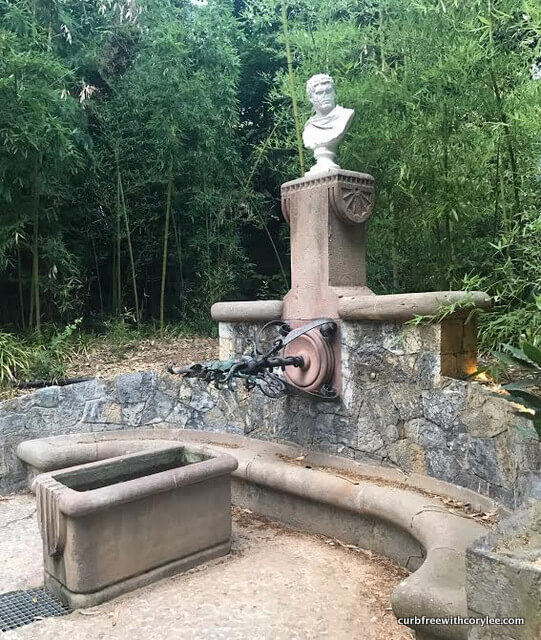
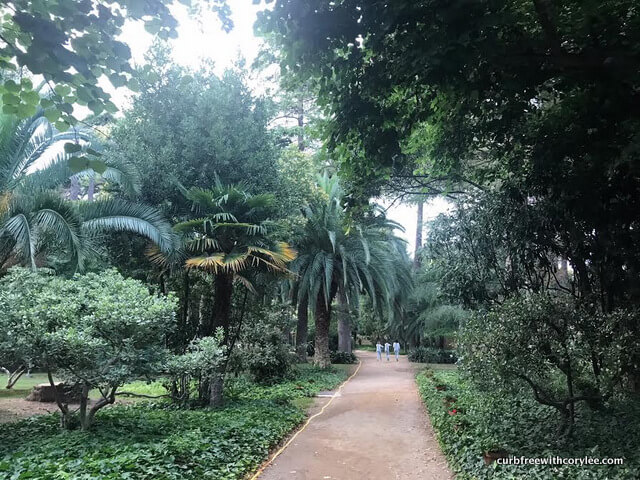
Accessibility: I had no problem rolling around the grounds of the park, and found the festival and concert to be quite wheelchair-friendly as well! Since it’s not the first park that tourists think of going to, it’s generally a bit less crowded, which can make it appealing for wheelchair users.
.
Hospital de Sant Pau
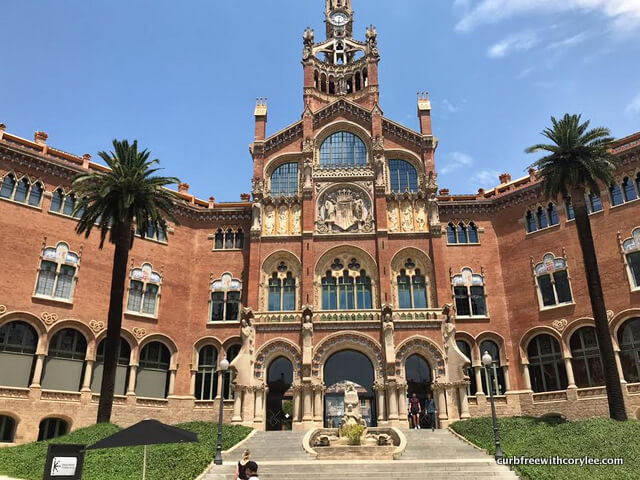
Why Visit: You’re probably wondering why I would recommend that you visit a hospital on tour of wheechair accessible Barcelona. While I certainly hope you don’t end up in one unexpectedly, this is a stop you should definitely plan to make! Let me explain. The Hospital of the Holy Cross and Saint Paul, as it is known in English, is no longer a functioning hospital. It was, until 2009, but now it has been completely remodeled into a cultural center and museum, which makes up one of UNESCO’s World Heritage Sites.
What made UNESCO value it so much? Well, it’s Europe’s largest Art Nouveau site and a tribute to a famous Catalan art figure, Lluís Domènech i Montaner. The outdoor gardens and paths around the building’s exterior are breathtaking, but the building hasn’t lost touch with its roots. Inside, you can take a tour that shows you what a real 1920s hospital ward was like.

How to Visit: I recommend taking an audio-guided tour of the hospital ward inside. Alternatively, you can buy your ticket here for a guided tour, where your guide will reveal the secrets of the site, both artistic and otherwise. You can also buy a combined ticket for this attraction and the neighboring Palau de la Musica Catalana. You might want to avoid going on the first Sunday of the month, as that is a free entrance day and it might be crowded — or, if you have a large party, you may want to take advantage of this! The Hospital opens at 9:30am every day of the week. It closes at 2:30pm on Sundays and holidays year-round and for the rest of the week, 4:30pm from November to March and 6:30pm from April to October.
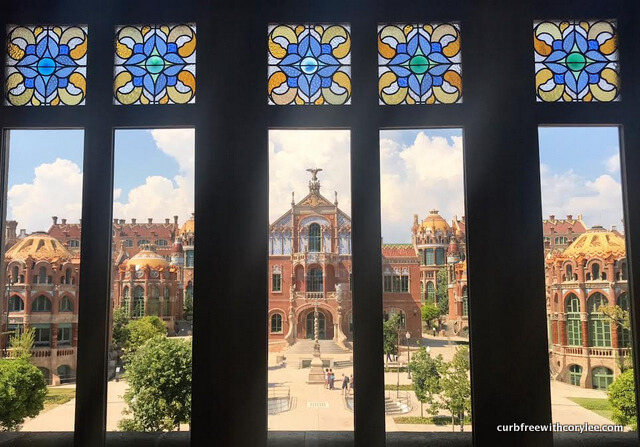
Accessibility: One thing I should mention here, and this applies for all the attractions, is that Spain generally divides people up into those who are more than 65% disabled and less than 65% disabled – this goes for wheelchair accessible Barcelona too. Often, those who are more than 65% will receive free admission into places with proper documentation stating their level of disability, and those less disabled may receive discounted admission. Most tourist attractions in Spain recognize that other countries don’t make this distinction, so just bring your paperwork and what you have to pay may vary depending on attraction. At the Hospital de Sant Pau, you’ll receive either free or discounted admission, and if it’s free, your companion will also receive free admission.
.
Barcelona Cathedral

Why Visit: This Gothic cathedral is well-known for its rooftop gargoyles and depictions of animals, both realistic and mystical, and its majestic stained glass windows. Overall, I’ve found that it imparts a calming and holy feeling on visitors, even if you’re not of the Catholic faith. The cathedral is dedicated to Eulalia, the co-patron Saint of Barcelona, and features a gift shop. Tourists enjoy seeing the 13 white geese kept in the cathedral’s cloister, a number meant to represent the age of the Saint Eulalia when she was martyred.
How to Visit: Tourists can visit the church from 12:30pm to 5:30pm on Saturdays, 12:30pm to 7:45pm on weekdays, and 2:30pm to 5:30pm on Sundays and religious holidays. If you’re Catholic, you may want to attend a worship and prayer at the church for a truly unique and immersive experience; if so, worship and prayer hours are from 8:30am to 12:30 pm and 5:45pm to 7:30pm on weekdays, 8:30am to 12:30pm and 5:15pm to 8:00pm on Saturdays, and 8:30am to 1:45pm and 5:15pm to 8:00pm on Sundays.
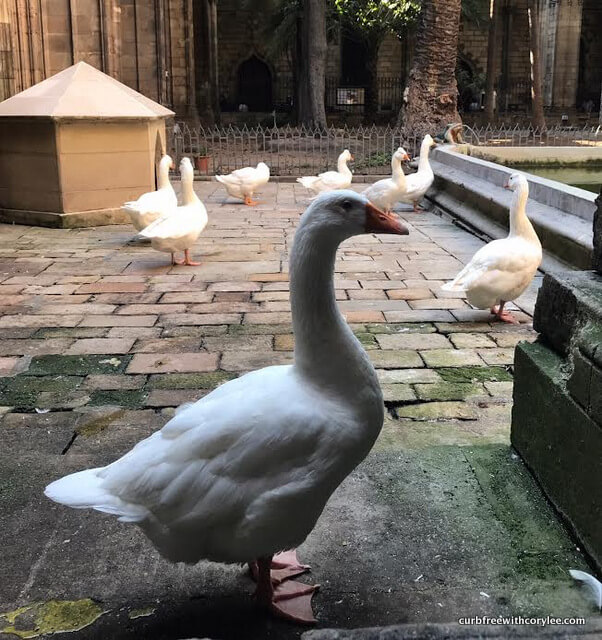
Accessibility: Though the main entrance to the cathedral features steep stairs, you’ll find a ramp at the Carrer del Bisbe, an entrance that will lead you directly in to the cloister. If there is not a ramp there, you’ll be able to request one at the main entrance. The central garden of the cloister is where you’ll find accessible restrooms if you need them. You’ll be able to wheel around in the church fine, though some of the chapels and crypts have stairs to access them. If you’re wheeling your way to the cathedral, you may encounter some hills. There aren’t too many hills in Barcelona, but the Gothic Quarter does have its fair share. It should be fine with a power chair, but manual wheelchair users may have a bit of difficulty. This is one part of wheelchair accessible Barcelona that requires a bit of extra forethought.
.
The Beach Life in Wheelchair Accessible Barcelona
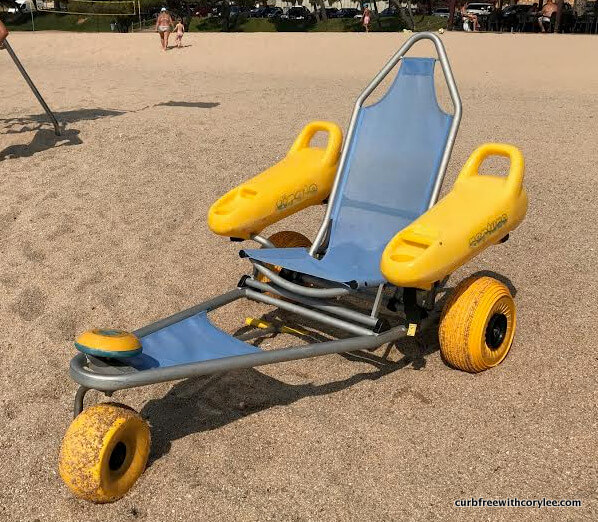
Barcelona has a lot of wheelchair-friendly beach access points. Ramps take you from city sidewalks down to the sand, where wooden ramps can then take you right to the water’s edge! It’s not hard to get access to a beach-worthy wheelchair for coastal visitors, either.
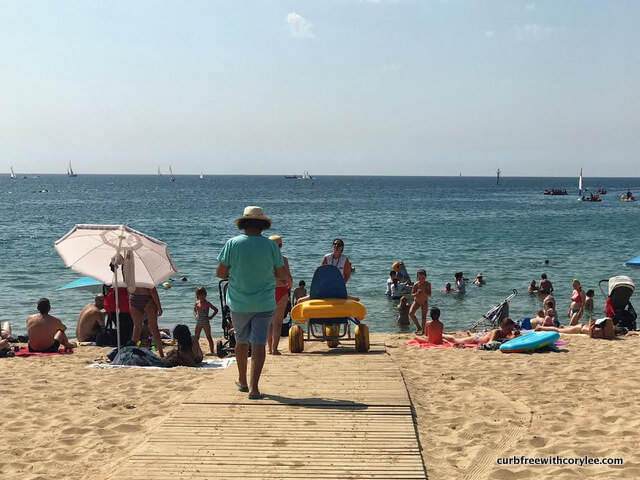
Where to Stay in Barcelona: ILUNION Almirante
How to Get Around Wheelchair Accessible Barcelona
Rolling Around
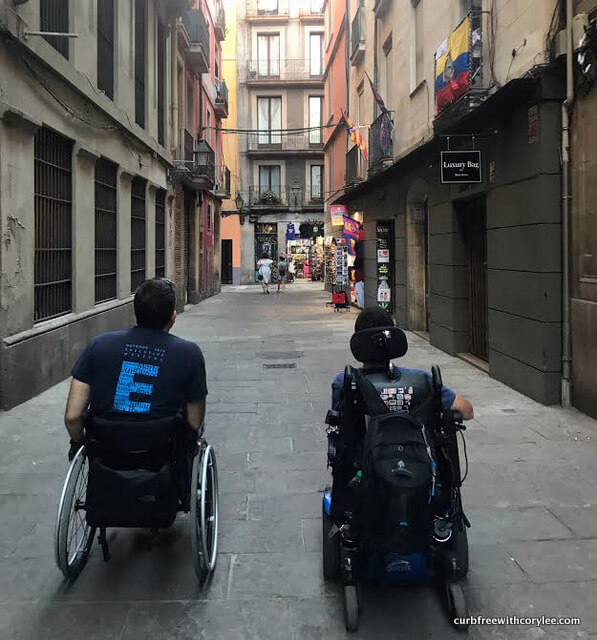
Barcelona is lauded as one of Europe’s most accessible cities, so it makes a great destination for wheelchair users like me. While there, I noticed that curb cuts are prevalent and there aren’t too many cobblestones, especially when compared to other European cities. In fact, Barcelona’s medieval Gothic corridor might be one of the smoothest on the continent! As I mentioned before, the Gothic quarter is the only place you might have to worry about small hills, but there are only a few and shouldn’t be a problem for power chairs. Though you wouldn’t know it from the picturesque mountains that cradle the city, the terrain in Barcelona itself is pretty flat in most places including the popular city center, making it fairly easy to roll wherever you’d like.
.
Accessible Taxis
Accessible taxis are a great option for transportation if you’re not in to public transportation – though Barcelona does have an excellent accessible metro and bus system, as I’ll discuss below! If you’re using an accessible taxi, it’s always a good idea to call a bit in advance to reduce waiting time. Here are some accessible taxi companies in Barcelona:
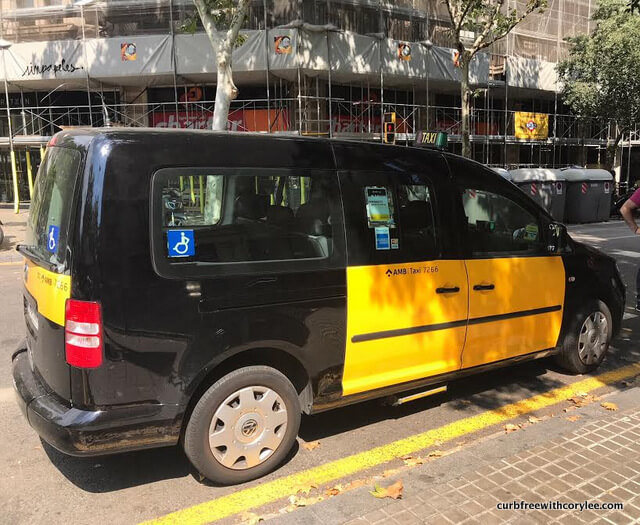
Taxi Amic is perhaps the only accessible taxi company in Barcelona that can transport mobility scooters. They’re specialists in accessible transportation with an extensive and varied fleet, and they are available every day of the year from 7:00am to 11:00pm like a regular taxi service. Of course, if you need transport outside those hours, they’ll also provide it, but they just need you to contact them in advance! They advise you to book a taxi a minimum of 24 hours in advance, and then they’ll contact you to confirm the trip.

This company has adapted vehicles for non-foldable wheelchairs in their fleet. You’ll just have to specify that you’d like one when you book online or by phone. They also offer airport transfers, transfers to nearby cities or locations, and even a variety of guided tours of wheelchair accessible Barcelona.
.
Metro
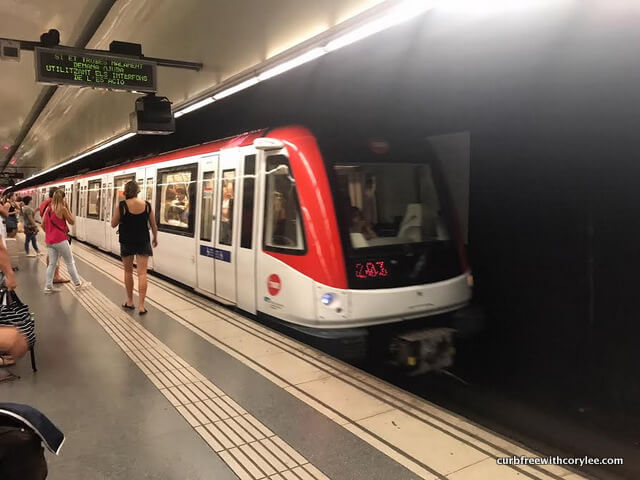
Barcelona’s metro is considered pleasantly accessible, especially in comparison to those of some other European cities. Most of the metro stations are accessible (only 15 out of the 158 are not), with elevators leading up to the platforms. I used the metro while there, and found it pretty easy just to roll right on the car.
If you’ve read my blog before, you’ll know that I always recommend planning out your itinerary in advance, including how you’re going to get from one place to another. This just facilitates smooth sailing and leads to a stress-free trip, the way vacations should be! In light of that, the wheelchair accessible Barcelona metro is an easy way to get between some of the hottest attractions. So, just to make sure the stations you’d like to use are accessible – and to plan out your route – you can check out this metro map.
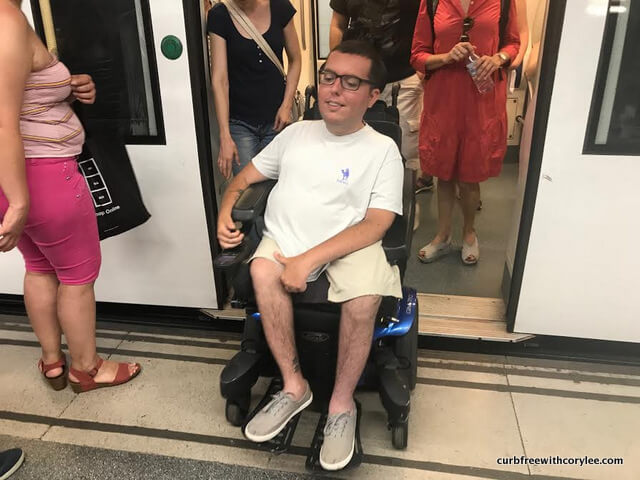
Tickets for the metro (and buses, which I’ll discuss next) can be bought from ticket vending machines at bus and metro stops.
.
Buses
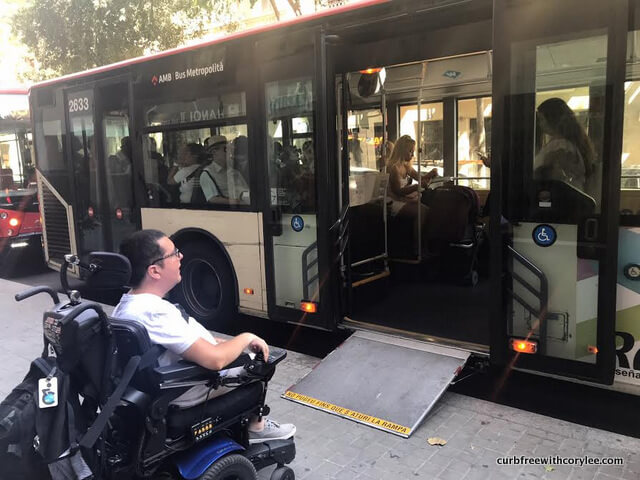
One hundred percent of Barcelona public buses are accessible, which is awesome news! Next-level bonus points for wheelchair accessible Barcelona. Like the metro, they’re also an easy and cheap way to navigate between attractions and around the city. All buses are fitted with ramps and have designated seating areas for people with reduced mobility. You’ll have to ask the driver to activate the ramp, and which door it’s at will vary depending on the bus. If you’re using city buses, I recommend planning your journey ahead of time using this handy bus route map.
On some buses you can buy a ticket from the driver, but they prefer exact change and don’t have change for large bills. You can’t buy tickets from the driver on bi-articulated buses, since the driver will be in a separate cabin.
Accessible Tour Companies in Barcelona
Barcelona Zero Limits

With Julián Montero
Barcelona Special Traveler
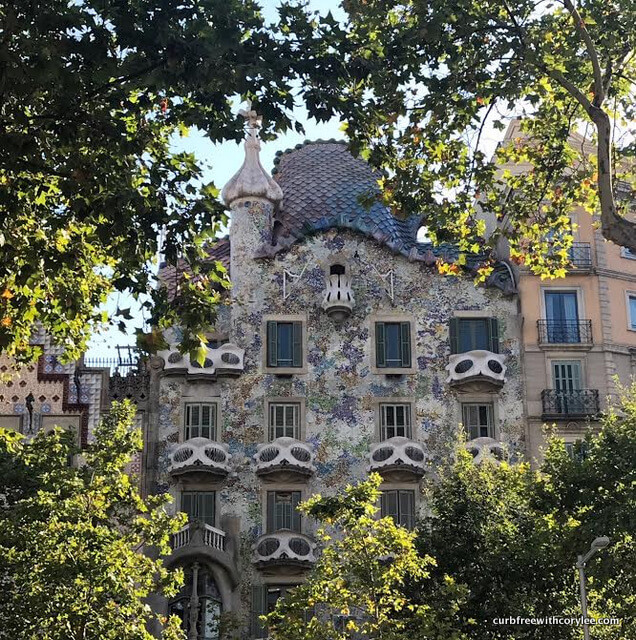
Accessible Tour of the Gothic Quarter
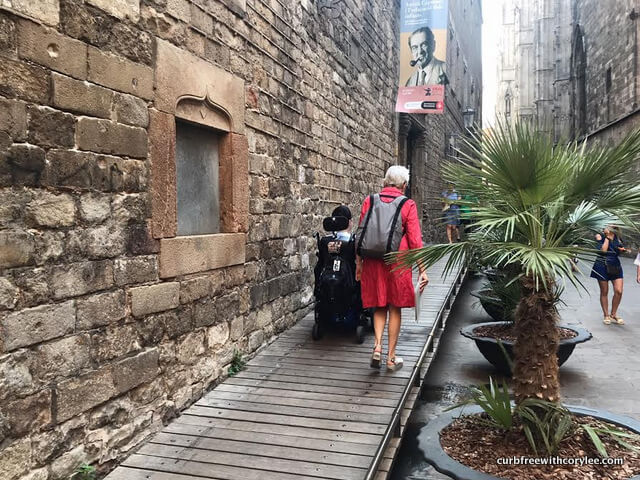
Is Barcelona Wheelchair Friendly?
 .
.
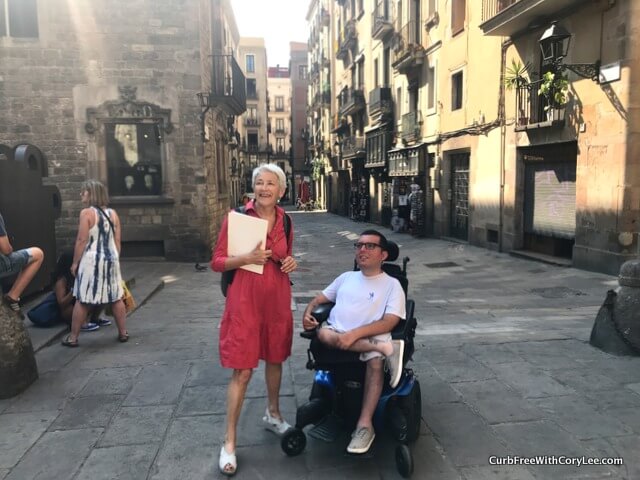

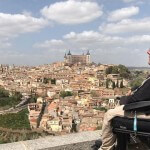


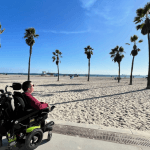

Great read Cory! Having been to Barcelona many years ago – pre child with disabilities, it was interesting to hear how accessible the city is. I guess the Barcelona Olympics had something to do with this.
I love Barcelona city. It is a good mobility friendly tourist place. Thanks for sharing the fantastic blog post.
I went to Barcelona 2 years ago and I was absolutely in love with the architectures. It seems like you had a great trip. Great post and safe travel Cory.
Luna Anderson recently posted…Best LED Lantern For Power Outages 2018 – Reviews & Buyer’s Guide